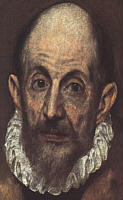
|
El Greco (meaning “The Greek”) was born in IrÂklion, Crete (then a possession of the Republic of Venice), in 1541 and was named Domenikos Theotokopoulos. Details of his early life and training are sketchy, but he probably first studied painting in his native city. Although no works from his first years survive, they were probably painted in the late Byzantine style popular in Crete at the time. Reminiscences of this style are seen in his later work. He was an erudite man, whose taste for classical and contemporaneous literature seems to have developed in his youth.
Early Work in Venice and Rome
About 1566, El Greco went to Venice, where he remained until 1570. He was employed in the workshop of Titian and was also strongly influenced by Tintoretto, both masters of the High Renaissance. Such early Venetian paintings as his Christ Healing the Blind Man (1566?-1567?, GemÄldegalerie, Dresden) demonstrate his assimilation of Titianesque color and of Tintoretto's figural compositions and use of deep spatial recesses. Further Italian inspiration came during the years El Greco spent in Rome, from 1570 to 1576. The sculptural qualities of the work of Italian artist Michelangelo inspired him, as is evident in his PietÁ (1570?-1572?, Philadelphia Museum of Art) and Purification of the Temple (1570?-1575?, Minneapolis Institute of Arts). A study of Roman architecture also reinforced the stability of his compositions, which often include views of Roman Renaissance buildings.
Move to Spain
In Rome he met several Spaniards associated with the church in Toledo, who may have persuaded him to come to Spain. In 1576 he left Italy and, after a brief sojourn in Malta, arrived in Toledo in the spring of 1577. He quickly began work on his first Spanish commission, producing for the Church of Santo Domingo el Antiguo the sumptuous Assumption of the Virgin (1577, Art Institute of Chicago), a painting that marks a turning point in his art. Although compositionally based on Titian's Assumption (1516-1518) in Santa Maria dei Frari in Venice, the colors and spatial relationships are less Italianate. A move toward nonnormative colors, groupings, and figural proportions became more marked in El Greco's art with each successive phase.
El Greco was anxious to be given the commission to fresco the walls of the newly built royal monastery-palace of El Escorial near Madrid, completed in 1582. He submitted several paintings to King Philip II for approval but was denied the commission. One of these, The Triumph of the Holy League (1578?-1579?, versions in El Escorial and in the National Gallery, London), proves his ability to combine complex political iconography with medieval motifs. El Greco also worked for Toledo Cathedral: The Disrobing of Christ (1577-1579) for the sacristy presents a splendid image of Christ in a rich red garment, closely surrounded by his captors. The work caused the first of several lawsuits brought by the artist against his patrons, who objected to its high price.
Emergence As a Spanish Master
In 1586 El Greco painted one of his greatest masterpieces, The Burial of Count Orgaz, for the Church of Santo TomÊ in Toledo. This work, still in place, portrays a 14th-century Toledan nobleman laid in his grave (in actuality situated just below the painting) by Saints Stephen and Augustine. Above, the count's soul rises to a heaven densely populated with angels, saints, and contemporary political figures. The Burial also manifests El Greco's typical elongation of figures and a horror vacui (dread of unfilled spaces), features of his art that became more pronounced in later years. These characteristics may be associated with international mannerism, which is still evident in the art of El Greco sometime after it had ceased to be widely popular in European painting. El Greco's intensely personal vision was rooted in his highly cultivated spirituality. Indeed, there is present in his canvases a mystical atmosphere similar to that evoked in the writings of such contemporaneous Spanish mystics as Saint Teresa of âvila and Saint John of the Cross, although no evidence exists that El Greco had any personal contact with them.
El Greco was a prosperous man. He had a large house in Toledo, where he received members of the nobility and the intellectual elite, such as the poets Luis de Gongora and Fray Hortensio Felix de Paravicino, whose portrait, painted by El Greco from 1609 to 1610, is now in the Museum of Fine Arts, Boston. El Greco also painted views of the city of Toledo itself, such as View of Toledo (1600?–1610?, Metropolitan Museum of Art, New York City), even though landscape was a genre traditionally neglected by Spanish artists.
Later Paintings
A feverish intensity can be sensed in many of El Greco's canvases dating from the 1590s until the time of his death. Baptism of Christ (signed in Greek, as was the artist's custom, 1596?-1600?) and Adoration of the Shepherds (1612-1614), both in the Prado, seem to pulsate with an eerie light generated by the holy figures themselves. In addition, the Adoration figures are enveloped by a steamy haze, observable in other late works, which intensifies the mystical nature of the event.
Subjects of classical mythology, such as the Laocoon (1610?–1614?, National Gallery, Washington, D.C.), and Old Testament history, such as the unfinished apocalyptic scene Opening of the Fifth Seal (1608?–1614?, Metropolitan Museum), attest to El Greco's humanistic learning and his brilliantly personal and novel approach to traditional themes. El Greco died in Toledo on April 7, 1614, and he was buried there in Santo Domingo el Antiguo.
|

